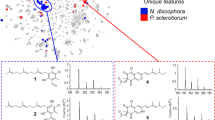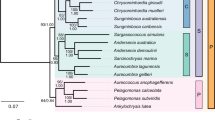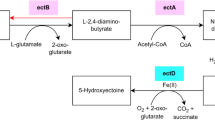Abstract
This research work aimed at investigating the chemistry and biosynthetic potential of ascidian-associated symbionts that originated from Manado Bay, North Sulawesi. We initially enriched the symbiotic cells associated with the Manadonese ascidian Lissoclinum patella. Subsequently we identified the presence of Prochloron didemni in both unenriched and salt-enriched samples by examining the 16S rRNA gene and the chlorophyll A oxygenase (CAO) gene. Investigation of the secondary metabolites by HPLC, LCMS/MS, and NMR showed the presence of ulithiacyclamide along with patellamide E in the unenriched symbiotic cells. Interestingly, ulithiacyclamide was detected in the enriched cells from the same Ascidian specimen. Molecular docking showed the high binding affinity of both compounds to estrogen receptor beta (ER-β) protein. This is a subtype of the nuclear receptor superfamily expressed abnormally in ovarian cancer cells. Furthermore, we isolated a patE gene variant encoding for a precursor with patellamide E (VTVCITFC) and ulithiacyclamide (CTLCCTLC) core peptides from the enriched cells. This represents a new core peptide combination. The outcome of this work provides a basis for producing useful cyclic peptides, in sustainable way, through symbiont cultivation. This could become a platform for bioengineering to generate diverse compound analogues.







Similar content being viewed by others
References
Antoniadou C, Gerovasileiou V, Bailly N (2016) Ascidiacea (Chordata: Tunicata) of Greece: an updated checklist. Biodivers. Data J
Behrendt L, Larkum AWD, Trampe E, Norman A, Sørensen SJ, Kühl M (2012) Microbial diversity of biofilm communities in microniches associated with the didemnid ascidian Lissoclinum patella. ISME J 6:1222–1237
Carroll AR, Copp BR, Davis RA, Keyzers RA, Prinsep MR (2019) Marine natural products. Nat Prod Rep 36:122–173
Chan K, Wei N, Liu S, Xiao-Yun L, Cheung A, Ngan H (2008) Estrogen receptor subtypes in ovarian Cancer: a clinical correlation. Obstet Gynecol 111:144–151
Chen L, Fu C, Wang G (2017) Microbial diversity associated with ascidians: a review of research methods and application. Symbiosis 71:19–26
Chen L, Hu J-S, Xu J-L, Shao C-L, Wang G-Y (2018) Biological and Chemical Diversity of Ascidian-Associated Microorganisms Mar Drugs 16
Czekster CM, Ge Y, Naismith JH (2016) Mechanisms of cyanobactin biosynthesis. Curr Opin Chem Biol 35:80–88
Comba PR, Gahan LR, Hanson G, Maeder M, Westphal M (2014) Carbonic anhydrase activity of dinuclear cu II complexes with patellamide model ligands. Dalton Trans 43:3144–3152
Davis AR (1991) Alkaloids and ascidian chemical defense: evidence for the ecological role of natural products fromEudistoma olivaceum. Mar Biol 111:375–379
Donia MS, Hathaway BJ, Sudek S, Haygood MG, Rosovitz MJ, Ravel J, Schmidt EW (2006) Natural combinatorial peptide libraries in cyanobacterial symbionts of marine ascidians. Nat Chem Biol 2:729–735
Donia MS, Fricke WF, Partensky F, Cox J, Elshahawi SI, White JR, Phillippy AM, Schatz MC, Piel J, Haygood MG et al (2011) Complex microbiome underlying secondary and primary metabolism in the tunicate-Prochloron symbiosis. Proc Natl Acad Sci 108:20291–20292
Fayette J, Coquard I, Alberti L, Boyle H, Méeus P, Decouvelaere A-V, Thiesse P, Sunyach M-P, Ranchère D, Blay J-Y (2006) ET-743: a novel agent with activity in soft-tissue sarcomas. Curr Opin Oncol 18:347–353
Franchi N, Ballarin L (2017) Immunity in Protochordates: the tunicate perspective. Front Immunol 8
Fu X, Do T, Schmitz FJ, Andrusevich V, Engel MH (1998) New cyclic peptides from the ascidian Lissoclinum patella. J Nat Prod 61:1547–1551
Hetényi C, van der Spoel D (2006) Blind docking of drug-sized compounds to proteins with up to a thousand residues. FEBS Lett 580:1447–1450
Hirose E (2015) Ascidian photosymbiosis: diversity of cyanobacterial transmission during embryogenesis. Genesis 53:121–131
Ireland C, Scheuer PJ (1980) Ulicyclamide and ulithiacyclamide, two new small peptides from a marine tunicate. J Am Chem Soc 102:5688–5691
Ireland CM, Durso AR, Newman RA, Hacker MP (1982) Antineoplastic cyclic peptides from the marine tunicate Lissoclinum patella. J Org Chem 47:1807–1811
Jimenez PC, Wilke DV, Branco PC, Bauermeister A, Rezende-Teixeira P, Gaudêncio SP, Costa-Lotufo LV (2019) Enriching cancer pharmacology with drugs of marine origin. Br J Pharmacol n/a
Joullié MM, Leonard MS, Portonovo P, Liang B, Ding X, La Clair JJ (2003) Chemical defense in ascidians of the Didemnidae Family. Bioconjug Chem 14:30–37
Kohfuku K, Yuko O, Yumi Y, Yutaka K, Taketoshi K, Yasuko S, Yasumasa H, Takayuki S (1989) Mechanistic aspects of the cytocidal action of ulithiacyclamide on mouse leukemia L1210 cells in vitro. Biochem Pharmacol 38:4497–4500
Kwan JC, Donia MS, Han AW, Hirose E, Haygood MG, Schmidt EW (2012) Genome streamlining and chemical defense in a coral reef symbiosis. Proc Natl Acad Sci 109:20655–20660
Lee S, Kim J-H, Yoo ES, Lee C-H, Hirochika H, An G (2005) Differential regulation of chlorophyll a oxygenase genes in rice. Plant Mol Biol 57:805–818
Martins J, Vasconcelos V (2015) Cyanobactins from cyanobacteria: current genetic and chemical state of knowledge. Mar Drugs 13:6910–6946
McDonald LA, Ireland CM (1992) Patellamide E: a new cyclic peptide from the ascidian Lissoclinum patella. J Nat Prod 55:376–379
Morris GM, Huey R, Lindstrom W, Sanner MF, Belew RK, Goodsell DS, Olson AJ (2009) AutoDock4 and AutoDockTools4: automated docking with selective receptor flexibility. J Comput Chem 30:2785–2791
Münchhoff J, Hirose E, Maruyama T, Sunairi M, Burns BP, Neilan BA (2007) Host specificity and phylogeography of the prochlorophyte Prochloron sp., an obligate symbiont in didemnid ascidians. Environ Microbiol 9:890–899
O’Boyle NM, Banck M, James CA, Morley C, Vandermeersch T, Hutchison GR (2011) Open babel: An open chemical toolbox. J Cheminformatics 3:33
Olguin-Uribe G, Abou-Mansour E, Boulander A, Débard H, Francisco C, Combaut G (1997) 6-Bromoindole-3-Carbaldehyde, from an Acinetobacter Sp. Bacterium Associated with the Ascidian Stomozoa murrayi J Chem Ecol 23:2507–2521
Palanisamy SK, Rajendran NM, Marino A (2017) Natural products diversity of marine ascidians (tunicates; Ascidiacea) and successful drugs in clinical development. Nat Prod Bioprospecting 7:1–111
Patterson GML, Withers NW (1982) Laboratory cultivation of Prochloron, a tryptophan auxotroph. Science 217:1034–1035
Long PF, Dunlap WC, Battershill CN, Jaspars M (2005) Shotgun cloning and heterologous expression of the patellamide gene cluster as a strategy to achieving sustained metabolite production. ChemBioChem 6 (10):1760–1765
Pinton G, Nilsson S, Moro L (2018) Targeting estrogen receptor beta (ERβ) for treatment of ovarian cancer: importance of KDM6B and SIRT1 for ERβ expression and functionality. Oncogenesis 7:1–11
Rashid MA, Gustafson KR, Cardellina JH, Boyd MR (1995) Patellamide F, a new cytotoxic cyclic peptide from the colonial ascidian Lissoclinum patella. J Nat Prod 58:594–597
Rath CM, Janto B, Earl J, Ahmed A, Hu FZ, Hiller L, Dahlgren M, Kreft R, Yu F, Wolff JJ, Kweon HK, Christiansen MA, Håkansson K, Williams RM, Ehrlich GD, Sherman DH (2011) Meta-omic characterization of the marine invertebrate microbial consortium that produces the chemotherapeutic natural product ET-743. ACS Chem Biol 6:1244–1256
Richardson AD, Aalbersberg W, Ireland CM (2005) The patellazoles inhibit protein synthesis at nanomolar concentrations in human colon tumor cells. Anti-Cancer Drugs 16:533–541
Roma A, Spagnuolo PA (2020) Estrogen receptors alpha and Beta in acute myeloid leukemia. Cancers 12
Rumengan IFM, Kubelaborbir TM, Tallei TE (2020) Data on the cultivation of Prochloron sp at different salinity levels Data Brief 29
Schmidt EW, Sudek S, Haygood MG (2004) Genetic evidence supports secondary metabolic diversity in Prochloron spp., the Cyanobacterial Symbiont of a tropical ascidian. J Nat Prod 67:1341–1345
Schmidt EW, Nelson JT, Rasko DA, Sudek S, Eisen JA, Haygood MG, Ravel J (2005) Patellamide a and C biosynthesis by a microcin-like pathway in Prochloron didemni, the cyanobacterial symbiont of Lissoclinum patella. Proc Natl Acad Sci U S A 102:7315–7320
Shenkar N, Swalla BJ (2011) Global diversity of Ascidiacea. PLoS One 6:e20657
Socha AM, Garcia D, Sheffer R, Rowley DC (2006) Antibiotic Bisanthraquinones produced by a Streptomycete isolated from a Cyanobacterium associated with Ecteinascidia turbinata. J Nat Prod 69:1070–1073
Spagnuolo C, Russo GL, Orhan IE, Habtemariam S, Daglia M, Sureda A, Nabavi SF, Devi KP, Loizzo MR, Tundis R, Nabavi SM (2015) Genistein and Cancer: current status, challenges, and future directions. Adv Nutr 6:408–419
Stoecker D (1980) Chemical defenses of ascidians against predators. Ecology 61:1327–1334
Tomitani A, Okada K, Miyashita H, Matthijs HCP, Ohno T, Tanaka A (1999) Chlorophyll b and phycobilins in the common ancestor of cyanobacteria and chloroplasts. Nature 400:159–162
Trott O, Olson AJ (2010) AutoDock Vina: improving the speed and accuracy of docking with a new scoring function, efficient optimization and multithreading. J Comput Chem 31:455–461
Tsukimoto M, Nagaoka M, Shishido Y, Fujimoto J, Nishisaka F, Matsumoto S, Harunari E, Imada C, Matsuzaki T (2011) Bacterial production of the tunicate-derived antitumor cyclic Depsipeptide Didemnin B. J Nat Prod 74:2329–2331
Urbach E, Robertson DL, Chisholm SW (1992) Multiple evolutionary origins of prochlorophytes within the cyanobacterial radiation. Nature 355:267–270
Uria AR, Piel J, Wakimoto T (2018) Biosynthetic Insights of Calyculin- and Misakinolide-Type Compounds in “Candidatus Entotheonella sp.”. Methods Enzymol 604:287–330
Wahl M, Jensen P, Fenical W (1994) Chemical control of bacterial epibiosis on ascidians. Mar Ecol Prog Ser 110:45–57
Williams AB, Jacobs RS (1993) A marine natural product, patellamide D, reverses multidrug resistance in a human leukemic cell line. Cancer Lett 71:97–102
Wilson KH, Blitchington RB, Greene RC (1990) Amplification of bacterial 16S ribosomal DNA with polymerase chain reaction. J Clin Microbiol 28:1942–1946
Acknowledgments
We thank to the Directorate of Research and Community Services, Indonesian Ministry of Research, Technology and Higher Education for financial support in 2018-2020 with a research scheme of basic priority/excellent university research (PDUPT). This work was partly supported by the Takeda Science Foundation, the Asahi Glass Foundation, the Japan Agency for Medical Research and Development (AMED Grant Number JP19ae0101045), and Grants-in-Aid from the Ministry of Education, Culture, Sports, Science and Technology (MEXT), Japan, JSPS KAKENHI (Grant Numbers JP16703511 and JP18056499). We are thankful to Adrianus Malintoi for his assistance in sample collection.
Author information
Authors and Affiliations
Corresponding authors
Ethics declarations
Conflict of interest
The authors declare they have no conflict of interest.
Additional information
Publisher’s note
Springer Nature remains neutral with regard to jurisdictional claims in published maps and institutional affiliations.
Supplementary Information
ESM 1
(DOCX 318 kb)
Rights and permissions
About this article
Cite this article
Rumengan, I.F.M., Roring, V.I.Y., Haedar, J.R. et al. Ascidian-associated photosymbionts from Manado, Indonesia: secondary metabolites, bioactivity simulation, and biosynthetic insight. Symbiosis 84, 71–82 (2021). https://doi.org/10.1007/s13199-021-00766-4
Received:
Accepted:
Published:
Issue Date:
DOI: https://doi.org/10.1007/s13199-021-00766-4




